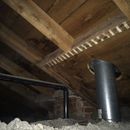Wood burning stove below – what to do?
I live in an 1883 2-story farmhouse that was converted into 5 small condos in 1983 complete with wood burning stoves. Four of the units have had the stoves removed. The unit below me still has it and I swear smoke comes into my place when they use it. City allows except for occasional Action Days of no burning. I told the unit owner but she is out of town so I can’t call her to come in and see for herself.
What would you do? Is there a way for me to test for smoke particulate? Picture attached –
GBA Detail Library
A collection of one thousand construction details organized by climate and house part










Replies
I'm not sure if there is an easy way to measure the particulate content, or whether it really matters. (What would you do with that information if you had it?)
The particulate emissions of circa 1983 wood stoves are an order of magnitude higher than current EPA rated stoves, but replacing it with a current model may not be the total solution to the problem, but it would be a start.
You can blower-door test your unit and air seal reducing air leakage between the condo units, common areas, and the great outdoors. If your unit is depressurized by stack effect and drawing in air from leaks near the woodstove's flue outlet that could be the entire issue. If you then install mechanical ventilation that draws air from a location well away from the flue outlet it could potentially solve the whole thing.
Changing wood stoves and adding mechanical ventilation are expensive. Air sealing alone might mitigate it to the point where it's tolerable, perhaps with portable room air filters that you turn on whenever you get the hint of smoke.
Mary,
There are several issues here.
1. Does your condo association have any rules on the use of wood stoves? Wood stove use raises liability concerns and fire safety concerns, and may increase the cost of insurance. If your condo association hasn't looked into this issue, you might want to bring up the issue at the next meeting of your condo association. The four condo owners who don't use a wood stove might not like the disadvantages of allowing wood stoves -- especially if only one condo owner now has a wood stove.
2. Many wood stove installations from the early 1980s didn't meet modern standards for safety. You might want to contact your local fire department and ask whether the department will send someone out to inspect the wood stove installation and venting system for safety -- assuming, of course, that your neighbor would agree to this type of inspection.
3. If smoke is entering your unit, that means that either (a) the wood stove venting system is defective, or (b) your condo is depressurized with respect to the outdoors (a situation that can happen when exhaust fans are operating), or (c) both of the above situations are occurring.
A short-term fix might involve installing a supply ventilation system that pressurizes your condo unit rather than depressurizing it. However, that's not a great solution -- especially if safety issues are involved.
Another hazard might be carbon monoxide. I suspect that you would be driven crazy by the smell long before CO became a problem, but it might be wise to get a CO monitor just in case.